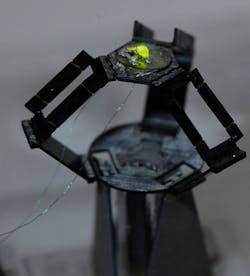Fast milliDelta piezoelectric actuator looks useful for optics and photonics labs
The so-called "delta" robot, which has three individually controlled and lightweight arms that guide a platform to move fast and accurately in 3D, is often used in industrial processes, including pick-and-place assemblies, machining, welding, and food packaging. Now, Robert Wood's group at Harvard University's Wyss Institute (Cambridge, MA) has come up with a miniature version, called the "milliDelta," that looks to be quite handy for laboratory use, including in photonics and biophotonics labs.
In 2011, inspired by pop-up books and origami, Wood's team developed a microfabrication approach that enables the assembly of robots from flat sheets of composite materials. Pop-up microelectromechanical systems (MEMS) manufacturing has since been used for the construction of dynamic centimeter-scale machines that can walk, or, as in the case of the RoboBee, can fly. In their new study, the researchers applied their approach to develop a delta robot measuring a mere 15 × 15 × 20 mm. The milliDelta design incorporates a composite laminate structure with embedded flexural joints that approximate the more complicated joints found in large-scale delta robots. The precision of the prototype is down to 5 μm at frequencies up to 75 Hz (with maximum frequency depending on the mass of what's being moved), with accelerations possible up to 22 g. The prototype milliDelta was used to move a green LED in programmed paths at high speed. "With the help of an assembly jig, this laminate can be precisely folded into a millimeter-scale delta robot. The milliDelta also utilizes piezoelectric actuators, which allow it to perform movements at frequencies 15 to 20 times higher than those of other currently available delta robots," says Hayley McClintock, a Wyss Institute staff researcher on Wood's team.
The researchers believe that specialized milliDelta robots could either be added on to existing robotic devices, or be developed as standalone devices such as, for example, platforms for the manipulation of biological cells in research and clinical laboratories. Reference: H. McClintock et al., Sci. Robot. (2018); doi:10.1126/scirobotics.aar3018.
About the Author
John Wallace
Senior Technical Editor (1998-2022)
John Wallace was with Laser Focus World for nearly 25 years, retiring in late June 2022. He obtained a bachelor's degree in mechanical engineering and physics at Rutgers University and a master's in optical engineering at the University of Rochester. Before becoming an editor, John worked as an engineer at RCA, Exxon, Eastman Kodak, and GCA Corporation.

